Deza M.M., Laurent M. Geometry of Cuts and Metrics
Подождите немного. Документ загружается.

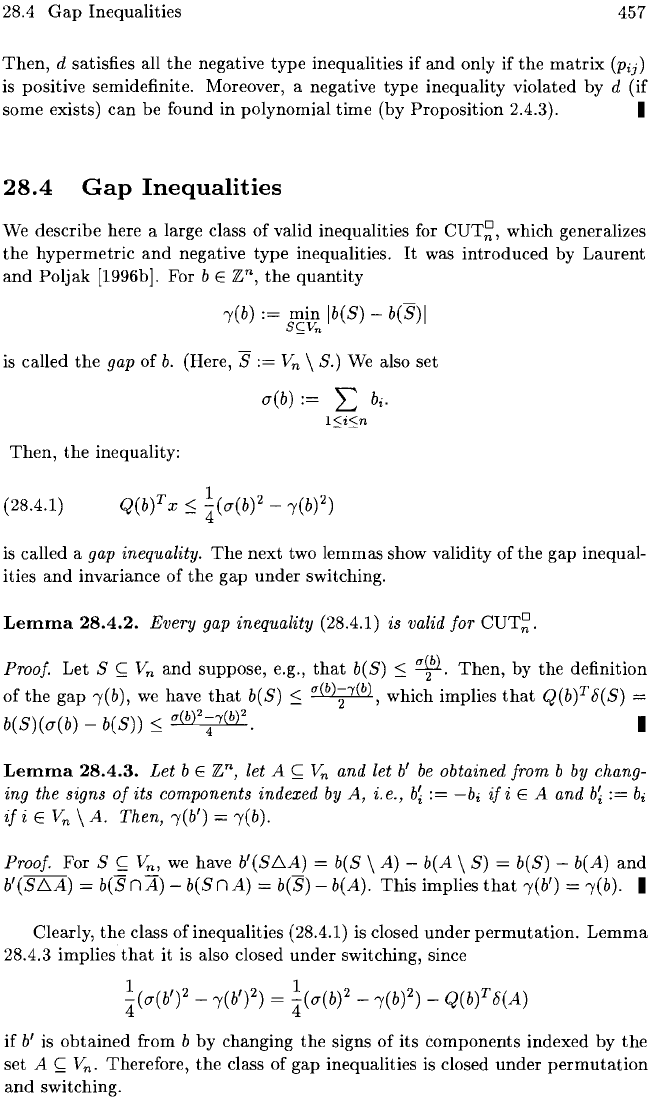
28.4
Gap
Inequalities
457
Then,
d satisfies all
the
negative
type
inequalities
if
and
only if
the
matrix
(Pij)
is positive semidefinite. Moreover, a negative type inequality violated by d (if
some exists)
can
be found in polynomial
time
(by
Proposition
2.4.3). I
28.4
Gap
Inequalities
We describe here a large class of valid inequalities for
CUT~,
which generalizes
the
hypermetric
and
negative
type
inequalities.
It
was
introduced
by
Laurent
and
Poljak
[1996b]. For
bE
zn,
the
quantity
feb)
:=
min
Ib(S) -
b(S)1
S<;;Vn
is
called
the
gap
of
b.
(Here, S
:=
Vn
\ S.) We also set
Then,
the
inequality:
(28.4.1)
a(b):=
L b
i
.
l::>i::>n
is
called a
gap
inequality.
The
next
two lemmas show validity
of
the
gap
inequal-
ities
and
invariance
of
the
gap
under
switching.
Lemma
28.4.2.
Every
gap
inequality (28.4.1) is valid for
CUT~.
Proof. Let S
~
Vn
and
suppose, e.g.,
that
b(S)
::;
~.
Then,
by
the
definition
of
the
gap
feb),
we
have
that
b(S)
::;
<7(b)~'Y(b),
which implies
that
Q(bf
O(S) =
b(S)(a(b) - b(S))
::;
<7(bj2~'Y(b)2.
I
Lemma
28.4.3.
Let b E
zn,
let A
~
Vn
and let
b'
be
obtained from b
by
chang-
ing the signs
of
its components indexed
by
A,
i.e., b::=
-bi
ifi
E A and b::= b
i
if
i E
Vn
\
A.
Then, f(b') = feb).
Proof.
For S
~
V
n
,
we
have b'(SL'-.A) = b(S \ A) - b(A \
S)
= b(S) - b(A)
and
b'(SL'-.A) =
b(SnA)
-
b(SnA)
= b(S)
-b(A).
This
implies
that
f(b') = feb). I
Clearly,
the
class of inequalities (28.4.1) is closed
under
permutation.
Lemma
28.4.3 implies
that
it
is also closed
under
switching, since
if
b'
is
obtained
from b by changing
the
signs
of
its
components indexed by
the
set A
~
V
n
.
Therefore,
the
class of gap inequalities is closed
under
permutation
and
switching.
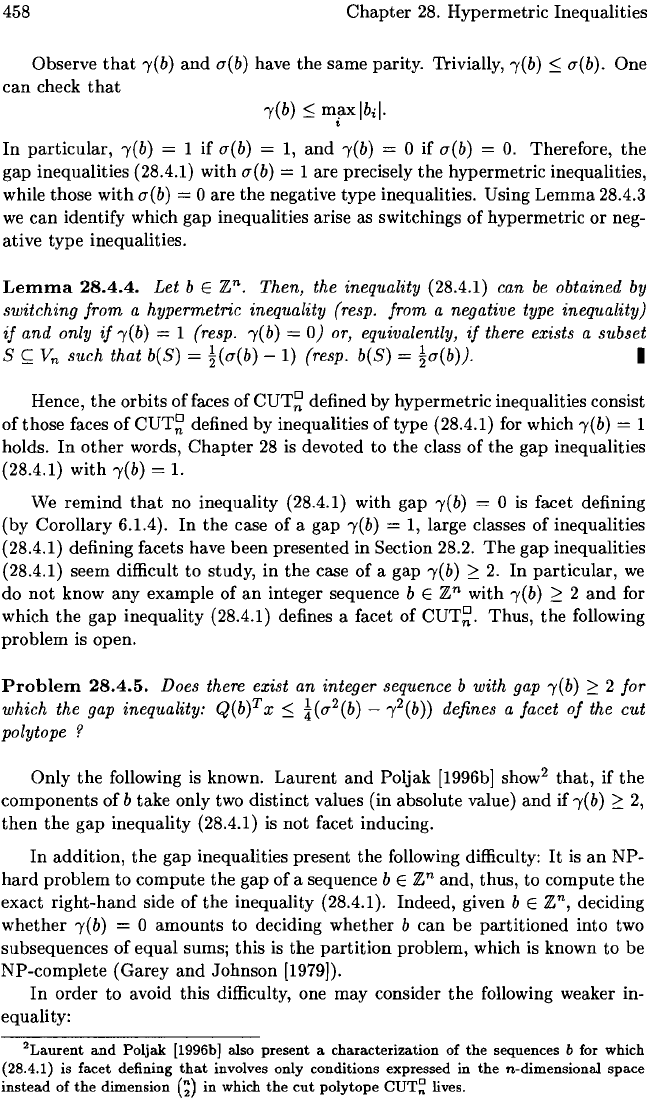
458
Chapter
28.
Hypermetric Inequalities
Observe
that
,(b)
and
a(b) have
the
same parity. Trivially,
,(b)
:S
a(b). One
can
check
that
,(b):S
ml1xlb;l.
•
In
particular,
,(b)
= 1 if a(b) =
1,
and
,(b)
= 0 if a(b) =
O.
Therefore,
the
gap inequalities (28.4.1) with a(b) = 1 are precisely
the
hypermetric inequalities,
while those with
a(b) = 0 are
the
negative type inequalities. Using
Lemma
28.4.3
we
can
identify which gap inequalities arise as switchings
of
hypermetric
or
neg-
ative type inequalities.
Lemma
28.4.4.
Let
b E
zn.
Then, the inequality (28.4.1) can
be
obtained by
switching
from
a hypermetric inequality (resp. from a negative type inequality)
if
and
only
if
,(b)
= 1 (resp.
,(b)
=
0)
or, equivalently,
if
there exists a subset
S
~
Vn
such that
b(S)
=
~(a(b)
-
1)
(resp.
b(S)
=
~a(b)).
I
Hence,
the
orbits
of
faces
of
CUT~
defined by hypermetric inequalities consist
of
those faces
of
CUT~
defined by inequalities
of
type (28.4.1) for which
,(b)
= 1
holds.
In
other
words,
Chapter
28
is
devoted to
the
class
of
the
gap inequalities
(28.4.1) with
,(b)
= 1.
We
remind
that
no inequality (28.4.1) with gap
,(b)
= 0
is
facet defining
(by Corollary 6.1.4).
In
the
case
of
a gap
,(b)
= 1, large classes
of
inequalities
(28.4.1) defining facets have been presented in Section 28.2.
The
gap inequalities
(28.4.1) seem difficult to study,
in
the
case
of
a gap
,(b)
2
2.
In
particular,
we
do
not
know any example
of
an
integer sequence b E
zn
with
,(b)
2 2
and
for
which
the
gap inequality (28.4.1) defines a facet
of
CUT~.
Thus,
the
following
problem
is open.
Problem
28.4.5.
Does there exist an integer sequence b with gap
,(b)
2 2
for
which the gap inequality: Q(b)T x
:S
!(a
2
(b) -
,2(b))
defines a facet
of
the
cut
polytope?
Only
the
following
is
known. Laurent
and
Poljak
[1996b]
show
2
that,
if
the
components
of
b take only two distinct values (in absolute value)
and
if
,(b)
2
2,
then
the
gap
inequality (28.4.1)
is
not facet inducing.
In
addition,
the
gap inequalities present the following difficulty:
It
is
an
NP-
hard
problem
to
compute
the gap
of
a sequence b E
zn
and, thus, to
compute
the
exact
right-hand
side
of
the
inequality (28.4.1). Indeed, given b E
zn,
deciding
whether
,(b)
= 0
amounts
to deciding whether b can
be
partitioned
into two
subsequences
of
equal sums; this
is
the
partition
problem, which
is
known to be
NP-complete (Garey
and
Johnson
[1979]).
In
order to avoid this difficulty, one may consider
the
following weaker in-
equality:
2Laurent
and
Poljak
[1996bJ also
present
a
characterization
of
the
sequences b for which
(28.4.1) is
facet
defining
that
involves
only
conditions expressed in
the
n-dimensional
space
instead
of
the
dimension
(~)
in
which
the
cut
polytope
CUT~
lives.
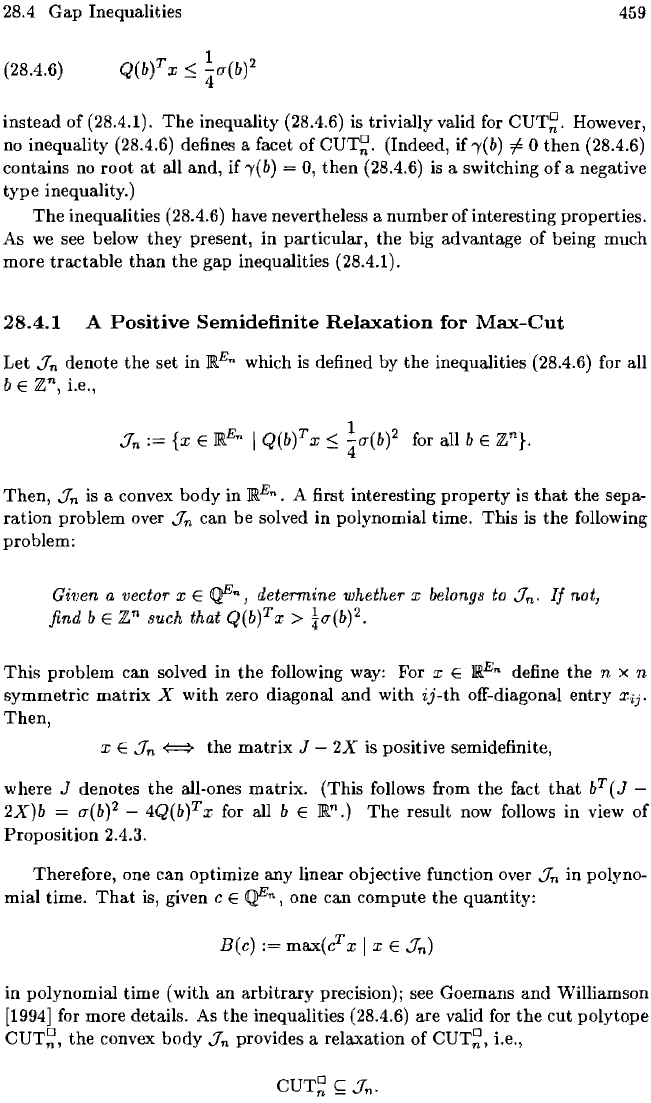
28.4 Gap Inequalities
459
(28.4.6)
instead
of
(28.4.1).
The
inequality (28.4.6) is trivially valid for
CUT~.
However,
no
inequality (28.4.6) defines a facet
of
CUT~.
(Indeed,
if
,),(b)
i=
0
then
(28.4.6)
contains no root
at
all and,
if
')'(b)
0,
then
(28.4.6)
is
a switching
of
a negative
type
inequality.)
The
inequalities (28.4.6) have nevertheless a number of interesting properties.
As
we
see below they present, in particular, the big advantage of being much
more tractable
than
the
gap inequalities (28.4.1).
28.4.1
A
Positive
Semidefinite
Relaxation
for
Max-Cut
Let
.:In
denote the set in
JRE
n
which
is
defined by the inequalities (28.4.6) for all
bE
zn,
Le.,
Then,
.:In
is
a convex body in
JRE
n
.
A first interesting property is
that
the sepa-
ration problem over
.:In
can
be
solved in polynomial time. This is
the
following
problem:
Given a vector x E
~n,
determine whether x belongs to
.:In.
If
not,
find b
E
zn
such that Q(b)T
x>
!0"(b)2.
This problem can solved in
the
following
way:
For x E
JREn
define the n x n
symmetric matrix X with zero diagonal
and
with
ij-th
off-diagonal entry
Xij'
Then,
x E
.:In'';=:;'
the
matrix
J -
2X
is positive semidefinite,
where
J denotes
the
all-ones matrix. (This follows from the fact
that
b
T
(J
2X)b
0"(b)2
- 4Q(b)T x for all b E
JRn.)
The
result
now
follows in view of
Proposition 2.4.3.
Therefore, one can optimize any linear objective function over
.:In
in polyno-
mial time.
That
is, given c E
~n,
one can compute the quantity:
B(c)
:=
max(c
T
x I x E
.:In)
in polynomial time (with an arbitrary precision); see Goemans
and
Williamson
[1994]
for more details.
As
the inequalities (28.4.6) are valid for
the
cut polytope
CUT~,
the convex body.:ln provides a relaxation
of
CUT~,
i.e.,
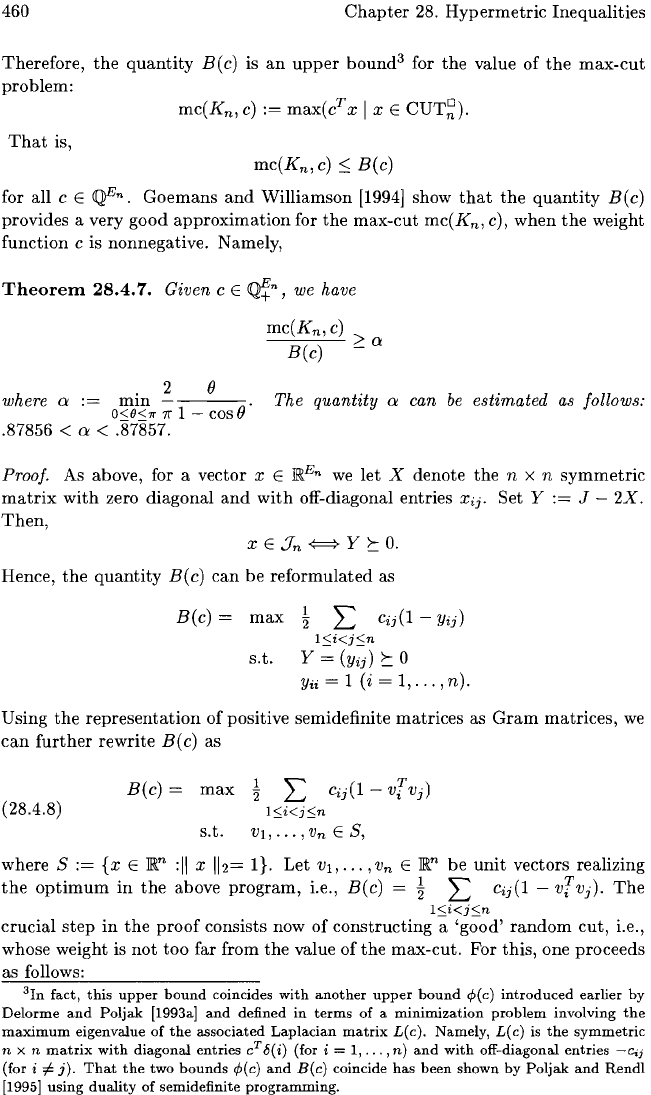
460
Chapter
28.
Hypermetric
Inequalities
Therefore,
the
quantity
B(c)
is
an
upper
bound
3
for
the
value of
the
max-cut
problem:
mc(Kn,
c)
:=
max(c
T
x 1 x E
CUT~).
That
is,
mc(Kn,
c)
:::;
B(c)
for all c E
~n.
Goemans
and
Williamson
[1994]
show
that
the
quantity
B(c)
provides a very
good
approximation
for
the
max-cut
mc(Kn,
c),
when
the
weight
function
c is nonnegative. Namely,
Theorem
28.4.1.
Given c E
~n,
we
have
mc(Kn,
c)
---'---'-'--'-
2:
0:
B(c)
h
.
2 0
were
0:
:=
O~}l!!1T
'If
1 _ cos
o·
.87856 <
0:
<
.8i857.
The quantity
0:
can
be
estimated
as
follows:
Proof. As above, for a vector x E
REn
we
let X denote
the
n x n
symmetric
matrix
with
zero diagonal
and
with
off-diagonal entries Xij. Set Y
:=
J -
2X.
Then,
x E In
~
Y
~
o.
Hence,
the
quantity
B(c)
can
be
reformulated
as
B(c)
=
max
~
L cij(1 - Yij)
I~i<j~n
s.t. Y = (Yij)
~
0
Yii
= 1 (i = 1,
...
, n).
Using
the
representation
of
positive semidefinite
matrices
as
Gram
matrices,
we
can
further
rewrite
B(c)
as
(28.4.8)
B(c)
=
max
~
L cij(1 -
v[
Vj)
I~i<j~n
s.t.
VI,
...
,V
n
E
S,
where S
:=
{x
E R
n
:11
x
112=
I}.
Let
VI,
...
,V
n
E R
n
be
unit
vectors realizing
the
optimum
in
the
above
program,
i.e.,
B(c)
=
~
L cij(1 -
v[
Vj).
The
I~i<j~n
crucial
step
in
the
proof
consists now
of
constructing
a
'good'
random
cut,
i.e.,
whose weight is
not
too
far from
the
value
of
the
max-cut.
For this, one proceeds
as follows:
3In
fact,
this
upper
bound
coincides
with
another
upper
bound
cp(c)
introduced
earlier
by
Delorme
and
Poljak
[1993a]
and
defined
in
terms
of
a
minimization
problem
involving
the
maximum
eigenvalue
of
the
associated
Laplacian
matrix
L(c).
Namely,
L(c) is
the
symmetric
n x n
matrix
with
diagonal
entries
c
T
8(i) (for i = 1,
...
,
n)
and
with
off-diagonal
entries
-C;j
(for i
-#
j).
That
the
two
bounds
cp(c)
and
B(c) coincide
has
been
shown
by
Poljak
and
Rendl
[1995]
using
duality
of
semidefinite
programming.
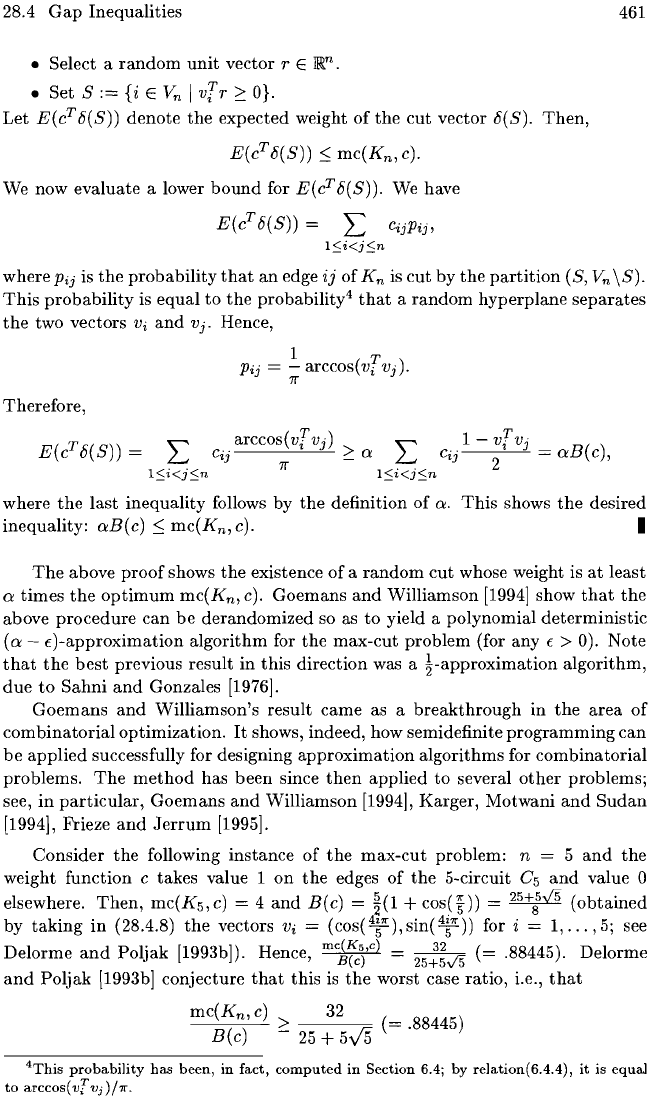
28.4
Gap
Inequalities
• Select a
random
unit
vector r E
lPl.
n
.
• Set S
:=
{i
E
Vn
I
v;
r
2:
O}.
Let
E(c
T
8(S))
denote
the
expected weight
of
the
cut
vector 8(S).
Then,
E(c
T
8(S))
:S
mc(Kn,c).
We now evaluate a lower
bound
for
E(c
T
8(S)). We have
E(c
T
8(S)) = L
CijPij,
l~i<j~n
461
where
Pij
is
the
probability
that
an
edge
ij
of
Kn
is
cut
by
the
partition
(S,
Vn
\S).
This
probability
is equal
to
the
probability4
that
a
random
hyperplane
separates
the
two vectors
Vi
and
Vj.
Hence,
Therefore,
1 T
Pij
= - arccos(vi
Vj).
7r
L
arccos(v;
Vj)
L 1 -
v;
Vj
B(
)
c··
> a
c··
= a c
..
'J
7r -
..
'J
2 '
l~'<J~n
l~'<J~n
where
the
last
inequality follows by
the
definition
of
a.
This
shows
the
desired
inequality:
aB(c)
:Smc(Kn,c).
I
The
above
proof
shows
the
existence
of
a
random
cut
whose weight is
at
least
a
times
the
optimum
mc(Kn,
c).
Goemans
and
Williamson
[1994]
show
that
the
above
procedure
can
be
derandomized so as
to
yield a polynomial
deterministic
(a
- E)-approximation algorithm for
the
max-cut
problem (for any E > 0). Note
that
the
best
previous result
in
this
direction was a
!-approximation
algorithm,
due
to
Sahni
and
Gonzales [1976].
Goemans
and
Williamson's result came as a
breakthrough
in
the
area
of
combinatorial
optimization.
It
shows, indeed, how semidefinite
programming
can
be
applied
successfully for designing
approximation
algorithms for combinatorial
problems.
The
method
has
been
since
then
applied
to
several
other
problems;
see,
in
particular,
Goemans
and
Williamson [1994], Karger, Motwani
and
Sudan
[1994]' Frieze
and
Jerrum
[1995].
Consider
the
following instance of
the
max-cut
problem: n = 5
and
the
weight function c takes value 1
on
the
edges of
the
5-circuit C
5
and
value 0
elsewhere.
Then,
mc(K
5
,c)
= 4
and
B(c)
=
~(1
+ cos(K)) = 25+;15
(obtained
by
taking
in
(28.4.8)
the
vectors
Vi
=
(cos(4~"'),sin(4~"'))
for i =
1,
...
,5; see
Delorme
and
Poljak [1993b]). Hence,
mcftcr
1
=
251~y'5
(=
.88445). Delorme
and
Poljak [1993b] conjecture
that
this
is
the
worst case ratio, i.e.,
that
mc(Kn,c)
> 32
(=.88445)
B(c)
-
25
+
5V5
'This
probability
has
been,
in
fact,
computed
in
Section
6.4;
by
relation(6.4.4),
it
is
equal
to
arccos(
vT
Vj)
/
7r.
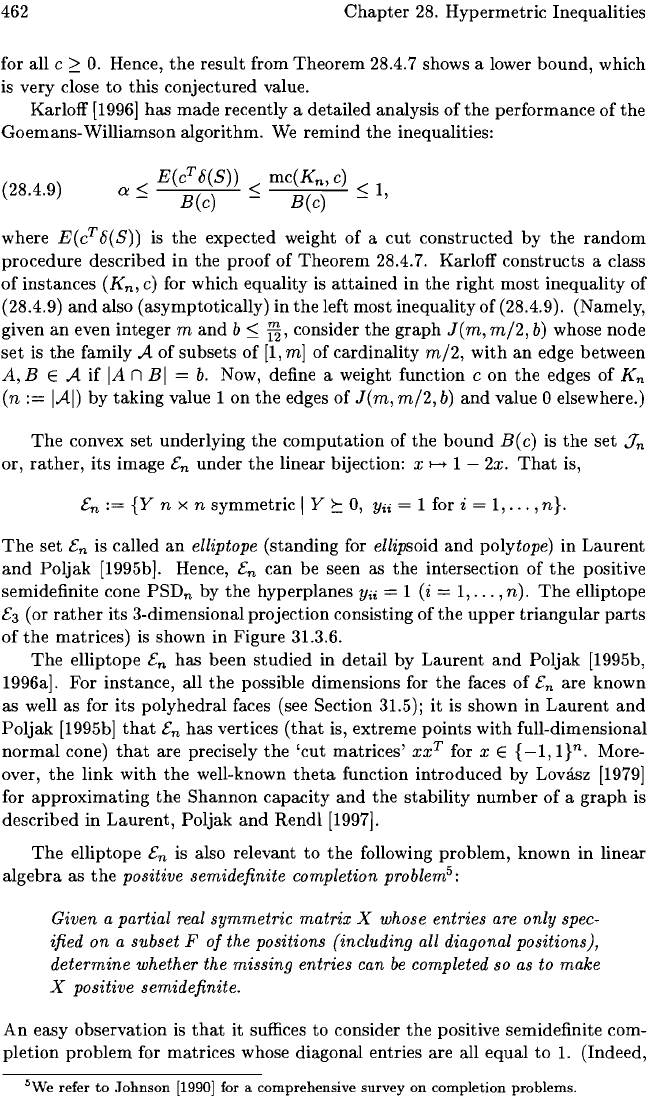
462
Chapter
28.
Hypermetric
Inequalities
for all c
2:
O.
Hence,
the
result
from
Theorem
28.4.7 shows a lower
bound,
which
is very close
to
this
conjectured value.
Karloff [1996]
has
made
recently a detailed analysis
of
the
performance
of
the
Goemans-
Williamson
algorithm.
We
remind
the
inequalities:
(28.4.9)
a
< E(c
T
6(5)) < mc(Kn,c) < 1
- B(c) - B(c)
-,
where
E(c
T
6(5)) is
the
expected
weight
of
a
cut
constructed
by
the
random
procedure
described
in
the
proof
of
Theorem
28.4.7. Karloff
constructs
a class
of
instances
(Kn' c) for which
equality
is
attained
in
the
right
most
inequality
of
(28.4.9)
and
also
(asymptotically)
in
the
left
most
inequality
of
(28.4.9). (Namely,
given
an
even integer m
and
b S
TI'
consider
the
graph
J(m,
m/2,
b)
whose
node
set
is
the
family A
of
subsets
of
[1,
m]
of
cardinality
m/2,
with
an
edge
between
A,
B E A
if
IA n BI =
b.
Now, define a weight function c
on
the
edges
of
Kn
(n
:=
IAI)
by
taking
value 1
on
the
edges
of
J(m,
m/2,
b)
and
value 0 elsewhere.)
The
convex set underlying
the
computation
of
the
bound
B(c) is
the
set
:Tn
or,
rather,
its image
En
under
the
linear bijection: x
1---+
1 - 2x.
That
is,
En
:=
{Y
n X n
symmetric
I Y
~
0,
Yii
= 1 for i = 1,
...
,
n}.
The
set
En
is called
an
elliptope
(standing
for ellipsoid
and
polytope) in
Laurent
and
Poljak
[1995b]. Hence,
En
can
be
seen as
the
intersection
of
the
positive
semidefinite cone
PSD
n
by
the
hyperplanes
Yii
= 1 (i = 1,
...
,n).
The
elliptope
E3
(or
rather
its 3-dimensional
projection
consisting
of
the
upper
triangular
parts
of
the
matrices)
is shown in
Figure
31.3.6.
The
elliptope
En
has
been
studied
in
detail
by
Laurent
and
Poljak
[1995b,
1996a].
For
instance, all
the
possible dimensions for
the
faces
of
En
are
known
as well as for
its
polyhedral
faces (see Section 31.5);
it
is shown in
Laurent
and
Poljak
[1995b]
that
En
has vertices
(that
is,
extreme
points
with
full-dimensional
normal
cone)
that
are
precisely
the
'cut
matrices'
xx
T
for x E
{-I,
l}n. More-
over,
the
link
with
the
well-known
theta
function
introduced
by
Lovasz
[1979]
for
approximating
the
Shannon
capacity
and
the
stability
number
of
a
graph
is
described
in
Laurent,
Poljak
and
Rendl
[1997].
The
elliptope
En
is also relevant
to
the
following
problem,
known in linear
algebra
as
the
positive semidefinite completion problem
5
:
Given a partial real
symmetric
matrix
X whose entries are only spec-
ified on a subset F
of
the positions (including all diagonal positions),
determine whether the missing entries can
be
completed so
as
to make
X positive semidefinite.
An
easy observation is
that
it
suffices
to
consider
the
positive semidefinite com-
pletion
problem
for
matrices
whose diagonal entries
are
all
equal
to
1.
(Indeed,
'We
refer
to
Johnson
[1990] for a
comprehensive
survey
on
completion
problems.
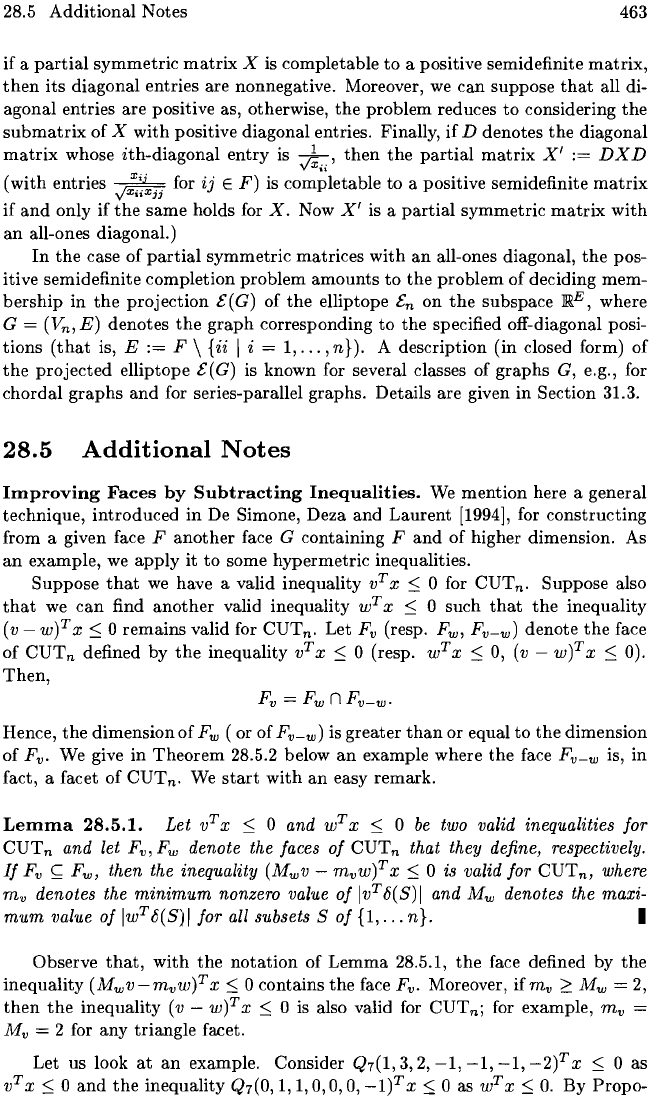
28.5
Additional
Notes
463
if
a
partial
symmetric
matrix
X is
com
pie
table
to
a positive semidefinite
matrix,
then
its
diagonal
entries are nonnegative. Moreover, we
can
suppose
that
all di-
agonal
entries
are
positive as, otherwise,
the
problem
reduces
to
considering
the
submatrix
of
X
with
positive diagonal entries. Finally,
if
D
denotes
the
diagonal
matrix
whose
ith-diagonal
entry
is
Jx
..
,
then
the
partial
matrix
X'
:=
DX
D
(with
entries ,;xx'.'x·
..
for
ij
E F) is
com;letable
to
a positive semidefinite
matrix
11
11
if
and
only
if
the
same
holds for
X.
Now
X'
is a
partial
symmetric
matrix
with
an
all-ones diagonal.)
In
the
case
of
partial
symmetric
matrices
with
an
all-ones diagonal,
the
pos-
itive semidefinite
completion
problem
amounts
to
the
problem
of
deciding
mem-
bership
in
the
projection
E(G) of
the
elliptope
En
on
the
subspace
lIRE,
where
G
= (Vn'
E)
denotes
the
graph
corresponding
to
the
specified off-diagonal posi-
tions
(that
is, E
:=
F \
{ii
I i = 1,
...
, n}). A description (in closed form)
of
the
projected
elliptope
E(
G) is known for several classes of
graphs
G, e.g., for
chordal
graphs
and
for series-parallel graphs. Details are given
in
Section 31.3.
28.5
Additional
Notes
Improving
Faces
by
Subtracting
Inequalities.
We
mention
here a
general
technique,
introduced
in
De Simone, Deza
and
Laurent
[1994], for
constructing
from a given face F
another
face G containing F
and
of
higher dimension. As
an
example,
we
apply
it
to
some
hypermetric
inequalities.
Suppose
that
we
have a valid inequality v
T
x
::;
0 for
CUT
n
.
Suppose
also
that
we
can
find
another
valid inequality w
T
x
::;
0 such
that
the
inequality
(v -
wl
x::;
0
remains
valid for
CUT
n
.
Let
Fv
(resp. F
w
, F
v
-
w
)
denote
the
face
of
CUTn
defined
by
the
inequality
vTx
::;
0 (resp.
wTx
::;
0, (v -
wlx
::;
0).
Then,
Fv
=
Fw
n F
v
-
w
.
Hence,
the
dimension
of
F w ( or
of
F
v
-
w
)
is
greater
than
or
equal
to
the
dimension
of
Fv' We give
in
Theorem
28.5.2 below
an
example where
the
face F
v
-
w
is, in
fact, a facet
of
CUT
n
. We
start
with
an
easy
remark.
Lemma
28.5.1.
Let
v
T
x
::;
0
and
w
T
x
::;
0
be
two valid inequalities
for
CUTn
and
let F
v
,
Fw
denote
the faces
of
CUTn
that
they
define, respectively.
If
Fv
~
F
w
,
then
the inequality
(Mwv
-
mvwl
x
::;
0 is valid
for
CUT
n
,
where
mv
denotes
the
minimum
nonzero value
of
Iv
T
6(8) I
and
Mw
denotes
the
maxi-
mum
value
of
Iw
T
b(8)1
for
all subsets 8
of
{I,
...
n}.
I
Observe
that,
with
the
notation
of
Lemma
28.5.1,
the
face defined
by
the
inequality
(Mwv-mvw)T
x
::;
0 contains
the
face Fv. Moreover,
ifmv
2:
Mw = 2,
then
the
inequality
(v
-
w)T
X
::;
0 is also valid for
CUTn;
for example,
mv
=
Mv
= 2 for
any
triangle
facet.
Let
us look
at
an
example. Consider Q7(1,
3,
2,
-1,
-1, -1,
-2l
x
::;
0 as
v
T
x
::;
0
and
the
inequality
Q7(0,
1,
1,0,0,0,
_1)T
X
::;
0 as w
T
x
::;
O.
By
Propo-
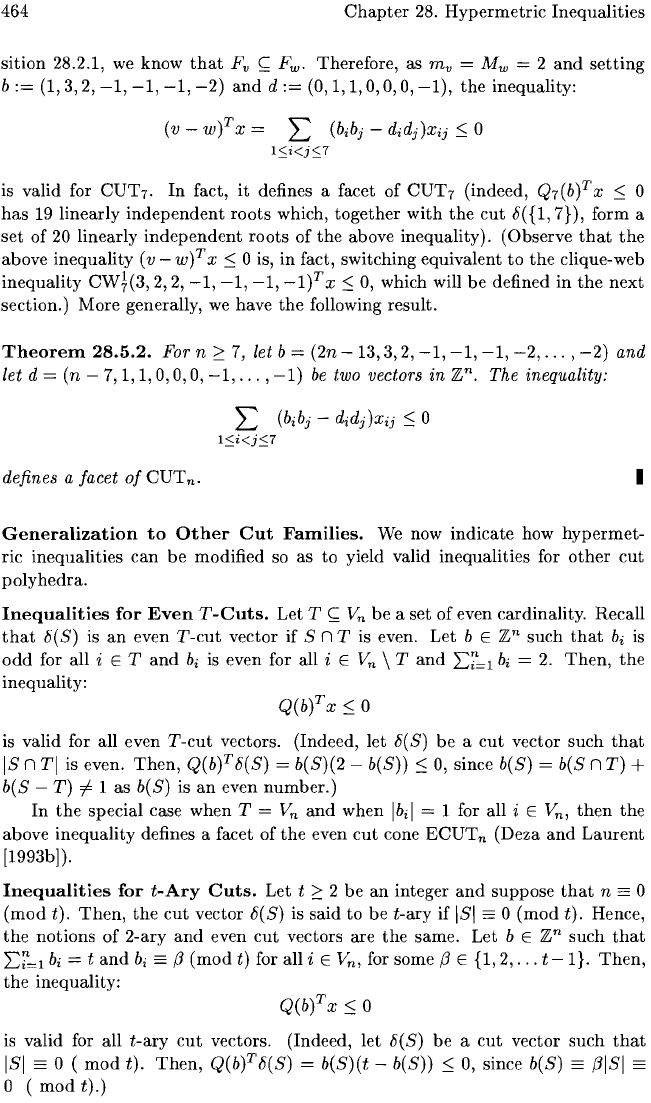
464
Chapter
28.
Hypermetric
Inequalities
sition
28.2.1, we know
that
Fv
~
Fw'
Therefore, as mv =
Mw
= 2
and
setting
b
:=
(1,3,2,
-1,
-1,
-1,
-2)
and
d
:=
(0,1,1,0,0,0,
-1),
the
inequality:
(v - wf x = L
(b;bj
- d;dj)x;j
::;
°
19<j::;7
is valid for CUT7.
In
fact,
it
defines a facet of CUT7 (indeed,
Q7(bf
x
::;
°
has
19
linearly
independent
roots
which,
together
with
the
cut
8(
{I,
7}), form a
set
of
20
linearly
independent
roots
of
the
above inequality). (Observe
that
the
above
inequality
(v - wf x
::;
° is,
in
fact, switching equivalent
to
the
clique-web
inequality
CWi(3,
2, 2,
-1,
-1,
-1,
-If
x
::;
0, which will
be
defined
in
the
next
section.) More generally, we have
the
following result.
Theorem
28.5.2.
For
n
2:
7,
let b = (2n -
13,3,2,
-1,
-1, -1, -2,
...
,-2)
and
let d
= (n -
7,1,1,0,0,0,
-1,
...
,-1)
be
two
vectors in
zn.
The inequality:
~
(bb - d'd')x" < °
~
, J
'J
'J-
defines a facet
of
CUT
n
.
I
Generalization
to
Other
Cut
Families.
We now
indicate
how
hypermet-
ric inequalities
can
be
modified so as
to
yield valid inequalities for
other
cut
polyhedra.
Inequalities
for
Even
T-Cuts.
Let T
~
Vn
be
a set of even cardinality. Recall
that
8(S) is
an
even
T-cut
vector
if
S
nTis
even.
Let
b E
zn
such
that
b
i
is
odd
for all i E T
and
b;
is even for all i E
Vn
\ T
and
2:i'=1
bi
=
2.
Then,
the
inequality:
Q(bfx::;o
is valid for all even
T-cut
vectors. (Indeed, let 8(S)
be
a
cut
vector
such
that
IS
n
TI
is even.
Then,
Q(bf
8(S) = b(S)(2 - b(S))
::;
0,
since b(S) = b(S n
T)
+
b(
S -
T)
i=
1 as
b(
S)
is
an
even
number.)
In
the
special case
when
T =
Vn
and
when
Ib;1
= 1 for all i E V
n
,
then
the
above
inequality
defines a facet of
the
even
cut
cone
ECUT
n
(Deza
and
Laurent
[1993b]).
Inequalities
for
t-Ary
Cuts.
Let t
2:
2
be
an
integer
and
suppose
that
n
==
°
(mod
t).
Then,
the
cut
vector 8(S) is
said
to
be
t-ary
if
lSI
==
°
(mod
t).
Hence,
the
notions
of
2-ary
and
even
cut
vectors are the same. Let b E
zn
such
that
2:i'=1
b;
= t
and
b;
==
(J
(mod
t) for all i E V
n
,
for some
(J
E
{I,
2,
...
t - I}.
Then,
the
inequality:
Q(bf
x::; °
is valid for all
t-ary
cut
vectors. (Indeed, let 8(S)
be
a
cut
vector
such
that
lSI
==
°
(mod
t).
Then,
Q(bf8(S)
= b(S)(t - b(S))
::;
0, since b(S)
==
(JISI
==
°
(modt).)
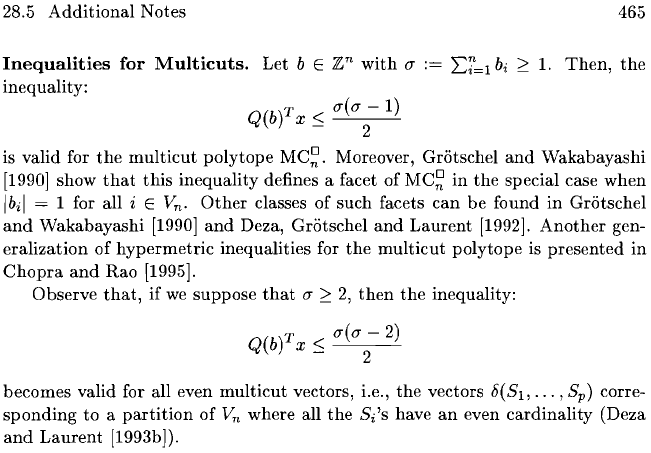
28.5
Additional
Notes
465
Inequalities
for
Multicuts.
Let b E
;En
with
eJ
:=
L:i=l
bi
;:::
1.
Then,
the
inequality:
Q(b)T
x::::
eJ(eJ
2-
1)
is valid for
the
multicut
polytope
MC~.
Moreover, Griitschel
and
Wakabayashi
[1990]
show
that
this
inequality
defines a facet of
MC~
in
the
special case
when
Ibil
= 1 for all i E V
n
.
Other
classes of such facets
can
be
found
in
Griitschel
and
Wakabayashi
[1990]
and
Deza, Griitschel
and
Laurent
[1992].
Another
gen-
eralization
of
hypermetric
inequalities for
the
multicut
polytope
is
presented
in
Chopra
and
Rao
[1995].
Observe
that,
if
we
suppose
that
eJ
;:::
2,
then
the
inequality:
becomes valid for all even
multicut
vectors, i.e.,
the
vectors
6(8
1
,
...
, 8
p
)
corre-
sponding
to
a
partition
of
Vn
where all
the
8;'s
have
an
even
cardinality
(Deza
and
Laurent
[1993b]).
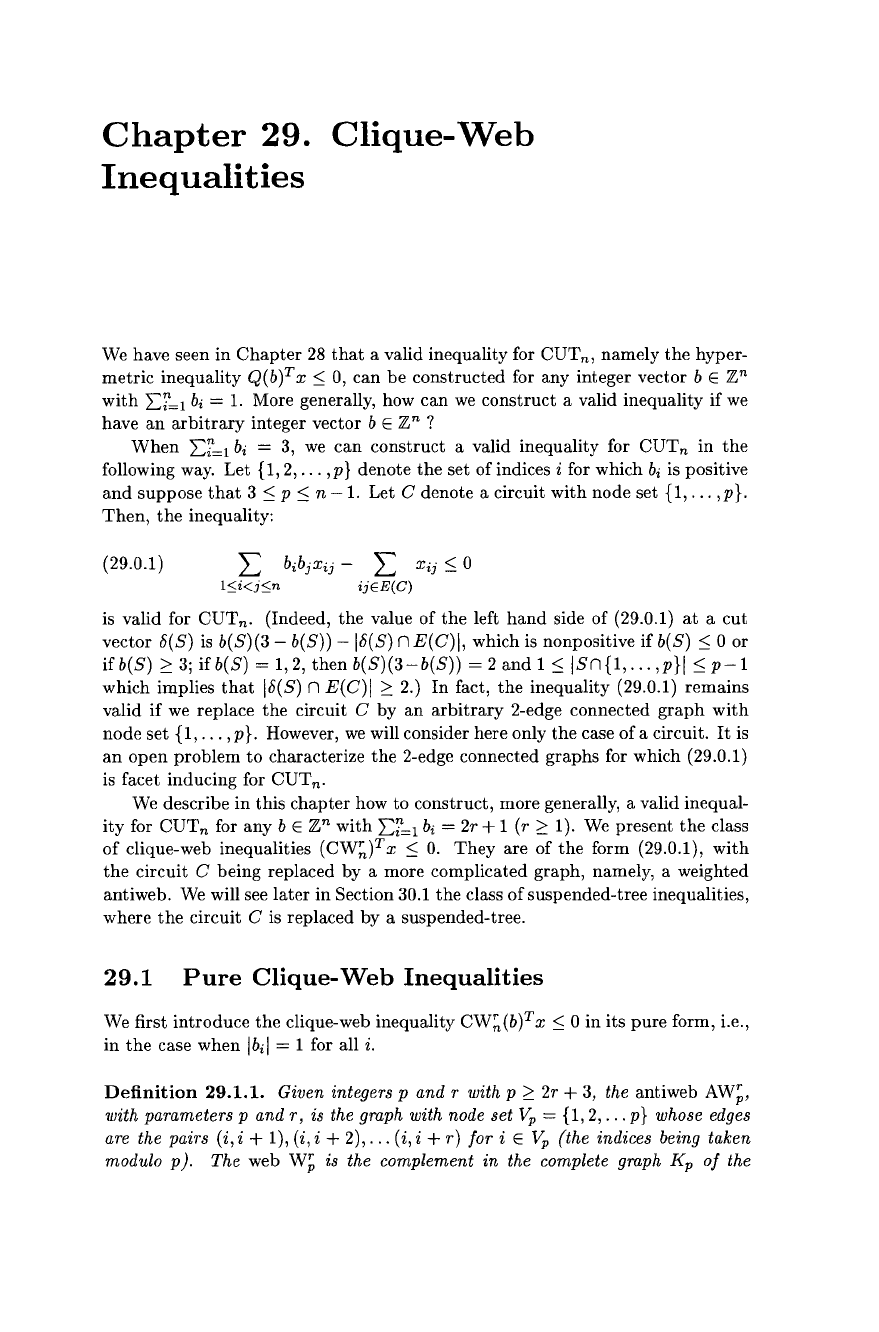
M.M. Deza, M. Laurent, Geometry of Cuts and Metrics, Algorithms and Combinatorics 15,
DOI 10.1007/978-3-642-04295-9_29, © Springer-Verlag Berlin Heidelberg 2010
Chapter
29.
Clique-Web
Inequalities
We have
seen
in
Chapter
28
that
a valid
inequality
for
CUT
n
,
namely
the
hyper-
metric
inequality
Q(b)T x
::::;
0,
can
be
constructed
for any integer
vector
b E
zn
with
~i=l
b
i
=
1.
More generally, how
can
we
construct
a valid
inequality
if
we
have
an
arbitrary
integer
vector
b E
zn
?
When
~i=l
bi
= 3, we
can
construct
a valid
inequality
for
CUTn
in
the
following way.
Let
{1,
2,
...
,p}
denote
the
set
of
indices i for
which
bi
is
positive
and
suppose
that
3
::::;
p
::::;
n - 1.
Let
C
denote
a
circuit
with
node
set
{1,
...
,p}.
Then,
the
inequality:
(29.0.1)
L bibjXij - L
Xij::::;
0
l:;i<j:;n ijEE(C)
is valid for
CUT
n
. (Indeed,
the
value
of
the
left
hand
side
of
(29.0.1)
at
a
cut
vector
8(S)
is
b(S)(3
-
b(S))
-18(S)
n E(C)I,
which
is
nonpositive
if
b(S)
::::;
0
or
if
b(S)
?:
3;
if
b(S)
=
1,2,
then
b(S)(3-b(S))
= 2
and
1
::::;
ISn{1,
...
,p}1
::::;
p-1
which
implies
that
18(S) n E(C)I
?:
2.)
In
fact,
the
inequality
(29.0.1)
remains
valid
if
we
replace
the
circuit
C
by
an
arbitrary
2-edge
connected
graph
with
node
set
{1,
...
,p}.
However,
we
will consider here
only
the
case
of
a circuit.
It
is
an
open
problem
to
characterize
the
2-edge
connected
graphs
for
which
(29.0.1)
is facet
inducing
for CUTn-
We
describe
in
this
chapter
how
to
construct,
more
generally, a valid inequal-
ity
for
CUTn
for
any
b E
zn
with
~~1
bi
=
2r
+ 1
(r
?:
1). We
present
the
class
of
clique-web
inequalities
(CW~)Tx
::::;
O.
They
are
of
the
form (29.0.1),
with
the
circuit
C
being
replaced
by
a
more
complicated
graph,
namely, a
weighted
antiweb.
We will see
later
in
Section 30.1
the
class
of
suspended-tree
inequalities,
where
the
circuit
C is
replaced
by
a
suspended-tree.
29.1
Pure
Clique-Web
Inequalities
We first
introduce
the
clique-web
inequality
CW~
(b)T x
::::;
0
in
its
pure
form, i.e.,
in
the
case
when
Ibil
= 1 for all i.
Definition
29.1.1.
Given
integers
p
and
r
with
p
?:
2r
+ 3,
the
antiweb
AW;,
with
parameters
p
and
r,
is
the
graph
with
node
set
Vp
=
{1,
2,
...
p}
whose
edges
are
the
pairs
(i, i +
1),
(i, i +
2),
...
(i, i +
r)
for
i E
Vp
(the
indices
being
taken
modulo
p).
The
web
W;
is
the
complement
in
the
complete
graph
Kp
of
the
